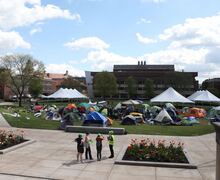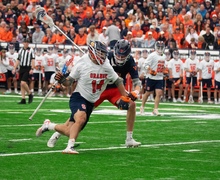SU students, faculty reflect on anti-Asian racism at forum
Nabeeha Anwar | Illustration Editor
Asian American students at SU discussed prevailing anti-Asian racism on campus and nationwide at Friday's open forum.
Get the latest Syracuse news delivered right to your inbox.
Subscribe to our newsletter here.
Syracuse University held an open forum Friday for students, faculty and staff to reflect on racism against the Asian community.
Yingyi Ma, director of Asian and Asian American studies at SU, and law professor Mary Szto moderated the discussion. Ma and Szto began with opening remarks before taking questions from the audience.
“One very concrete thing we can do is fund, give more resources to our Asian and Asian American studies program,” Szto said. “We’re under-resourced. We’re underfunded. That’s something we can start here at the university.”
The pair discussed prevailing racism impacting Asian and Asian American students at SU and the greater community nationwide — the narrative where the U.S. teeters between viewing the Asian and Asian American community as “non-assimilable” and “models of assimilation,” Szto said.
But this dates back to the 1800s, she said. The rhetoric heightens once in a while, as it did following the Sept. 11 attacks and as it is now, amid the pandemic.
Anti-Asian racism was engraved in the government through laws, which translated onto the street in mob violence, Szto said. All parts of government and society will need to contribute to the solution because this racism was written in the law for decades, she said.
Historic examples of anti-Asian racism in the U.S. include the Chinese Exclusion Act of 1882, which banned emigration from China for 20 years, and the internment of Japanese immigrants and Japanese Americans during World War II.
Though the campus community doesn’t have control over legislation, SU can still help. But Szto and Ma don’t fully blame the university for the lack of resources — that comes from society conveying Asian Americans as the “model minority,” Szto and Ma said. This stereotype leads people to view Asian Americans as “resilient and brilliant,” Szto said.
“Basically, all of us are made in the image of God,” Szto said.
The Asian American community has been reluctant to express frustrations about the racism it experiences, Ma said. The “model minority” status places an expectation on the Asian American community where Asian people are expected to ignore the barriers, challenges or sufferings in their lives and simply overcome them, she said.
The Asian and Asian American communities are even expected to overcome their identity, Ma said. The “Asian American” social category has been challenged over time, with many in the community choosing to identify with their ethnic identity rather than their racial identity.
But the narrative continues to exist, with American society using the Asian umbrella to categorize those who are Korean, Japanese and Chinese, Ma said.
Too often, after racist incidents take place, there’s outrage and discussions of change, but few changes result, Ma said. She said that there are tangible steps the university can take to help alleviate the frustrations of its Asian American community. Szto agreed.
SU — as well as every college campus — needs to provide sufficient support for Asian American students, Szto said. Students need a place to talk about trauma, stress and anxiety, said Szto, who suggested that SU hire more Asian American counselors for the Barnes Center at The Arch in the near future.
She also called on individual schools and departments at SU to better support Asian and Asian American students in the immediate future.
Szto believes the SU community and the nation are at a pivotal moment where they can decide to better support Asian Americans.
“We’ve waited 150 years for this moment where we’re having a
conversation with public officials and institutions at SU, where we’re having a conversation about the anti-Asian racism and violence,” Szto said. “We are at a moment, at an inflection point, and I believe we can take hold of this moment, be part of the movement to
fight.”
Published on March 26, 2021 at 10:04 pm





